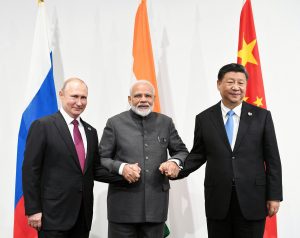While Ukraine is under siege, India’s foreign policy has come under the scanner in unprecedented ways. At a meeting of the United Nations Security Council last week, India was one of only three countries that abstained on the U.S.-sponsored resolution criticizing Russia’s invasion. India was joined on the fence by China and the United Arab Emirates.
New Delhi’s vote triggered concern and criticism across the West in its aftermath. President Volodymyr Zelensky of Ukraine specifically singled out India in a tweet, asking for New Delhi’s cooperation at the U.N. in vigorous terms.
Fence-sitting on a global crisis is not a new feature of Indian foreign policy. India has no official stand on the war in Yemen, for instance, nor North Korea’s flurry of missile launches, nor Haiti’s struggle for stability after the assassination of its former president. The principle has long been to maintain an arm’s length distance from anything that is not happening near India’s own borders.
But Ukraine’s invasion is a strategically significant moment, different from these other long-running challenges. A nuclear power has just launched an unprovoked assault on the West’s fragile frontier and threatened the sovereignty of a relatively stable democratic state. At a Quad summit only days ago, the U.S., Japan, and Australia had raised alarm over Russia’s military buildup, leaving India isolated. The U.S. then asked India for its support, linking the situation in Ukraine to China’s aggression in the Indo-Pacific. India rebuffed that appeal.
It also hasn’t helped New Delhi’s cause that it is now a member of the U.N. Security Council, seeking to use its two-year term to make a case for permanent membership and thereby inviting more scrutiny from the world.
Analysts have offered several reasons for why India is sitting on the fence on Ukraine. The most compelling rationale is India’s strong dependence on Russia for military equipment, half of which still comes from Moscow. But in the wake of increasingly severe sanctions from the West, Russia’s own defense capabilities will be under strain and its defense supplies to New Delhi less reliable. Russia’s strategic partnership with China also lends doubt as to whether Moscow can be a reliable security partner to New Delhi, especially in the event of a war with China.
For all these reasons, India has been making efforts to diversify its arms supply for years. While over 75 percent of India’s arms imports in the period 2006-10 came from Russia, that figure fell to under 50 percent in 2016-20.
But there is another plausible strategic reason for India’s fence-sitting: Prime Minister Narendra Modi simply cannot afford to cut off China and Russia – a move that would make his government more dependent on the West.
In recent years, Washington and New Delhi have unprecedentedly been at odds with each other over democratic values. Even before the Biden administration came to power, many of its members, including Vice President Kamala Harris, had lashed out at the Modi government for its Hindu nationalist policies. Last month, while the world was watching the escalation around Ukraine, Hindu nationalist politicians were in the midst of a politically motivated assault on Muslim university students, barring them from wearing the hijab while pointedly permitting Hindu religious symbols. That controversy drew an additional rebuke from the U.S. and more ripostes from New Delhi in response to the rebuke.
In order to preserve its strategic space, therefore, India has been particularly cautious in its dealings with even China, the supposed number one threat in the eyes of most Delhi analysts. In the aftermath of the Galwan clashes, for instance, Modi has continued to refrain from naming China as the aggressor. When the West boycotted Beijing’s Winter Olympics this year in order to protest against human rights violations in China, India initially joined Russia in backing China’s role as the host.
In response to India’s abstention on Ukraine, the U.S. responded sympathetically, noting that India has a “distinct” relationship with Russia. But the growing list of differences should spark a reckoning in both Washington and Beijing over how far the West can consider India an ally, and – more importantly – on what issues India is a reliable ally.
When the Bush administration pursued a historic strategic pivot towards India in the mid-2000s, it had made its case on the basis of shared values — positioning India as a democratic counterweight to China in the Asia-Pacific. The idea was that a democratic India will champion many of the same norms that the U.S. seeks in global governance, owing to its commitment to rule of law, democracy, secularism, and liberalism. That view won rare bipartisan approval in Washington. In my book, “Flying Blind: India’s Quest for Global Leadership,” I too argued that a secular, liberal India would want to promote those very values for both strategic and principled reasons.
But it isn’t clear that the Modi government shares that vision of India or the world.
































